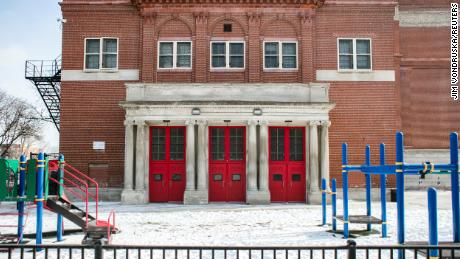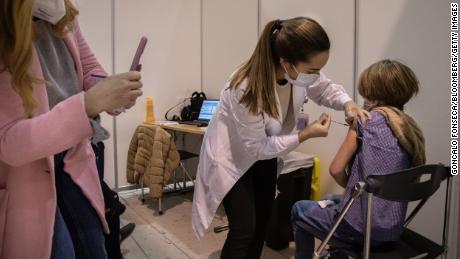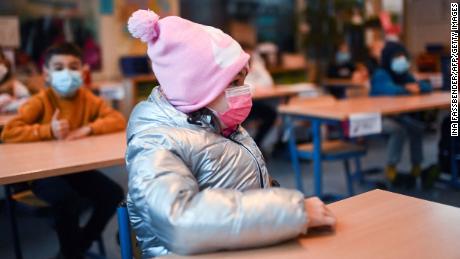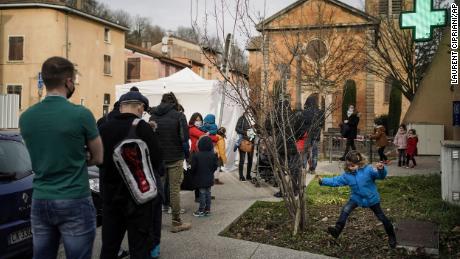Guest, a head teacher at an elementary school in Birmingham, England, scoured Amazon for affordable air purifiers in the hopes of stopping the more transmissible Omicron variant from spreading among his 460 students, who are between 3 and 11 years old.
“I got what I think is the best air purifier for the budget I have available. I hope I’ve got something that’s doing the job, but I’m not an expert. And there’s been no guidance put out by the Department for Education. I’ve had to do it all myself, and I shouldn’t have to do that when it’s a national crisis,” Guest said.
Millions of British students have returned to school following the Christmas and New Year holidays, amid a record surge in infections and hospitalizations. For teachers and parents, the situation has brought a grim sense of déjà vu. Unlike last January, when the rampaging Alpha variant plunged the United Kingdom into another lockdown, Prime Minister Boris Johnson has decided to “ride out” the Omicron wave with limited restrictions and to keep schools open, citing the toll remote education has taken on students’ mental health and learning.
letter.
testing requirements and temporary masking for students in middle and high schools, but not for elementary school students. The department said it would be providing
7,000 air-cleaning units for teaching spaces where quick fixes, like opening windows, are impossible — approximately one for every three schools in England. To plug staffing gaps, the UK’s education minister has also suggested combining classes, and called on retired teachers to show
“Blitz spirit” to return to the classroom.
“It’s woefully inadequate,” said Guest of the government’s measures. “They keep saying education is their number one priority. It’s clear it absolutely isn’t.” Last Wednesday, five of his staff, including three of his 15 classroom teachers, were out sick or isolating — the most absent from Guest’s school since the start of the pandemic — and he said he feared more would follow.
record rise in pediatric infections in the United Kingdom, parts of Europe and the United States, threatens to upend the shaky balance that allowed schools to mostly stay open last year — albeit with targeted classroom closures. It’s also cast a harsh spotlight on just how little has been done in some places to protect students, with teachers resorting to propping open windows in freezing weather and frequently checking carbon dioxide monitors while delivering their lessons.
delaying the new term, while a teachers’ union has forced public schools in
Chicago, Illinois, to shutter amid criticism from members that conditions in classrooms are dangerous.
studies in the UK, Australia, US and Italy have shown that spread among children in school settings is typically lower than — or at least similar to — levels of community transmission, when mitigation strategies like masks are in place. But experts are waiting to see whether the more contagious Omicron variant may change that calculus, and trigger an explosion in cases in classrooms.
study by the UCL Great Ormond Street Hospital in central London found. According to the
UK Office of National Statistics (ONS), 117,000 children in the UK are now living with long Covid.
Omicron appears to be causing milder illness than previous variants, but early research has also suggested that Omicron may trigger more upper-airway problems, which can be more dangerous for young children, potentially leading to croup and bronchiolitis.
“This narrative that it’s just a mild virus is not accurate,” Dr. Peter Hotez, co-director for vaccine development at Texas Children’s Hospital, told CNN’s Jake Tapper last week, remarking on the surge in Covid-19 hospitalizations at America’s largest pediatric hospital.
“We’ve just done a terrible job vaccinating our kids across the country. … So even though there’s a lot of happy talk about the Omicron variant, less severe disease, when you add up all the factors … we’ve got a very serious situation facing us in this country, especially for the kids.”
About 17% of US children age 5 to 11 are fully vaccinated; the vast majority of children in hospital in the US are unvaccinated, according to CDC director Rochelle Walensky.
Dr. Hans Kluge, said in early December that masks and ventilation, combined with testing, should be a standard in all primary schools and that vaccinating children should be considered nationally.
clinically vulnerable children. That has vexed some parents, with British news reports of at least
one mother driving to Europe to get her daughter vaccinated.
ONS data.
“We’re going to see a big surge in kids. And it’s going to be very, very disruptive,” Pagel said. “Their teachers are going to get it, and probably in about a month or two, their parents are going to get it. We’re going to see a prolonged high level of infection.”
Pagel, a member of Independent SAGE, a group of expert scientific advisers unaffiliated with the government, said the British government has been an outlier in its attitude to infections in children and has failed to use mitigation strategies deployed successfully elsewhere — crucially, ventilation and masks.
British Medical Journal, she highlighted the successes of countries like Norway and Japan, which have kept schools open through preventative measures, like spacing out classroom desks, using outdoor spaces as much as possible, avoiding crowding and using rigorous hand-washing practices. Pagel also noted that parts of the US and Europe, including France, Spain, Italy and Germany, have successfully mandated masks for elementary, middle and high school children, with surges in cases when rules were relaxed.
study in Germany found that requiring children and adults to wear face masks in schools could significantly reduce Covid-19 transmissions and outbreaks, because clusters were generally more severe when an adult was the source. Studies released by the
US Centers for Disease Control and Prevention (CDC) have also shown the efficacy of masks in limiting Covid-19 transmission in education settings. One study found that schools in
two of Arizona’s most populous counties without mask requirements were 3.5 times more likely to have a Covid-19 outbreak than schools that required all people, regardless of vaccination status, to wear a mask indoors. The CDC recommends universal masking for all schools.
December analysis of protocols in French schools, which used data from the country’s spring wave of infections, found that regular testing and vaccination against Covid-19 were the most effective ways to minimize closures. It also suggests that viral circulation among children in schools is much higher than in the general community, resulting in greater risk of infection for students’ household members.
As students return to school amid Omicron, many scientists and public health experts are asking: If keeping schools open is so important for children, then why are we skimping on measures that could protect them?
“It’s quite terrifying looking at the number of children who are being infected and hospitalized every week. And the fact that they are going into schools now with a highly transmissible variant with almost no mitigations and with the vast majority unvaccinated,” Dr. Deepti Gurdasani, a clinical epidemiologist at Queen Mary University of London, said of the situation in England. “The rhetoric still very much seems to be to keep schools open at all costs … rather than the real discussion we should be having, which is how do we keep schools open safely.
“I’m not even sure many parents realize the sort of risks that children are facing every day. And there are countries that have done so much better than us,” she added, noting successes in Southeast Asia and Western Europe, particularly in curtailing airborne transmission.
The same strategies that have made Southeast and East Asia so successful at suppressing the virus — widespread mask use, improved ventilation, comprehensive contact testing and tracing programs, and supported isolation — have also allowed them to limit disruption to education, Gurdasani said, flagging public health measures in Japan, Singapore, South Korea, and Taiwan. They’ve also remained dynamic, shifting protective measures depending on cases, and quickly moving to hybrid learning.
€500 million ($427 million) in October 2020 in improving ventilation systems in public buildings, including schools, including upgrading air conditioning systems and purifiers, described by the then-Chancellor Angela Merkel as “one of the cheapest and most effective ways” of containing the spread of the virus.
air purifiers for every classroom after extensive ventilation surveys, which helped keep its positivity rate around
1%, lower than the city-wide rate of 3%, into December — though that number has since
soared to 31% amid the Omicron surge.
advisory groups and scientists to improve ventilation in schools, the government has said repeatedly that there were no funds to do so. Britain’s centrist Liberal Democrats suggested recently that England could fit air filters in all classrooms for
£140 million ($190 million) — around half the cost of the new royal yacht.
Gurdasani, who is immunosuppressed, was anxious to send her 6-year-old daughter to school this week. She said she had been trying to get HEPA filtration devices into her classroom for six months before a charity agreed to fund them. Her daughter, who has asthma, wore an N95 mask on her first day back — but she was the only one in her class wearing a face covering.
“She’s a shy child, and nobody in her school is wearing masks, nobody at all. And, you know, she feels very out of place, and as a 6-year-old, that’s very hard. But I don’t know what else to do.”







